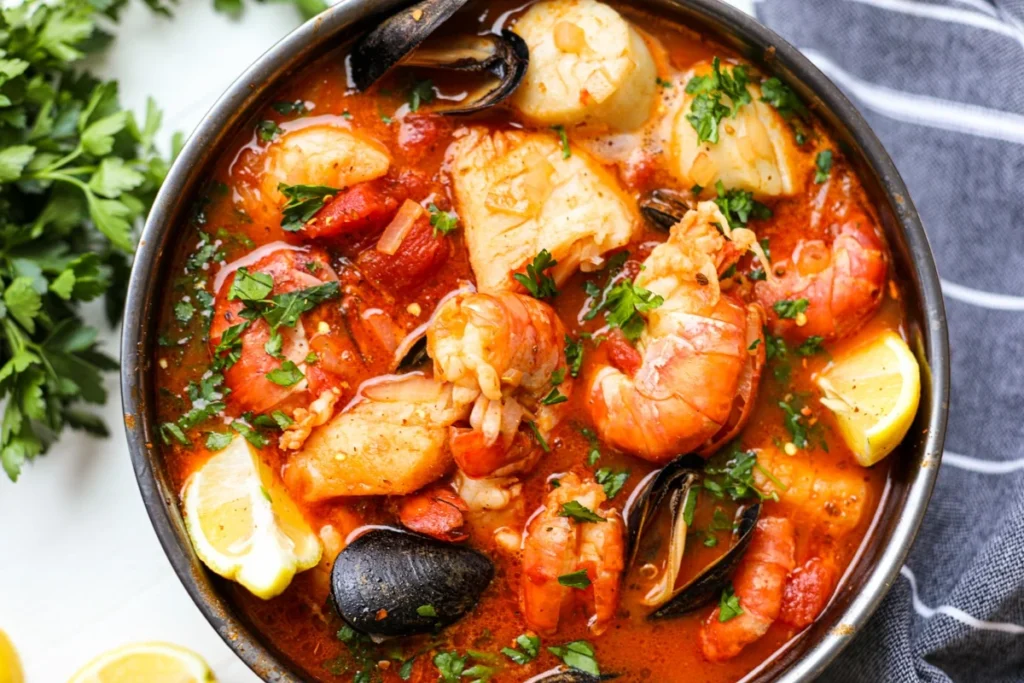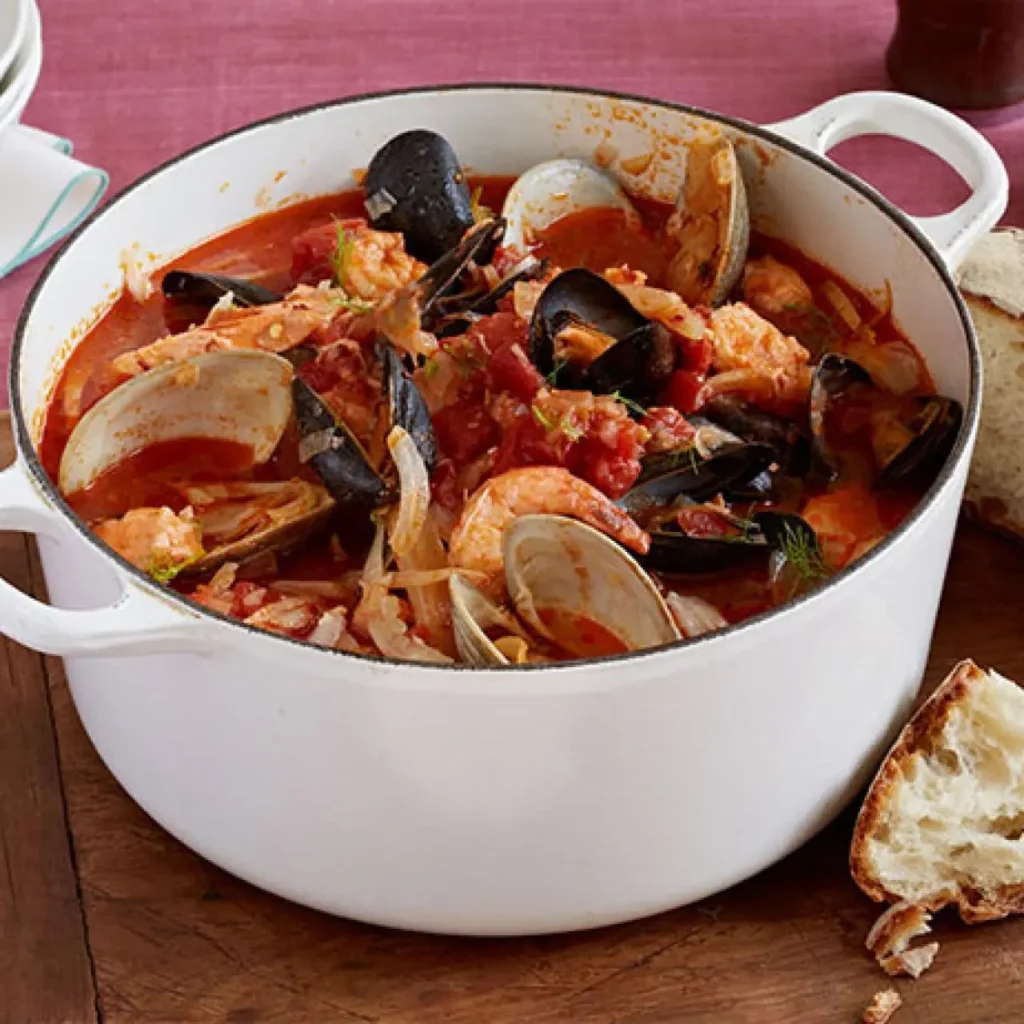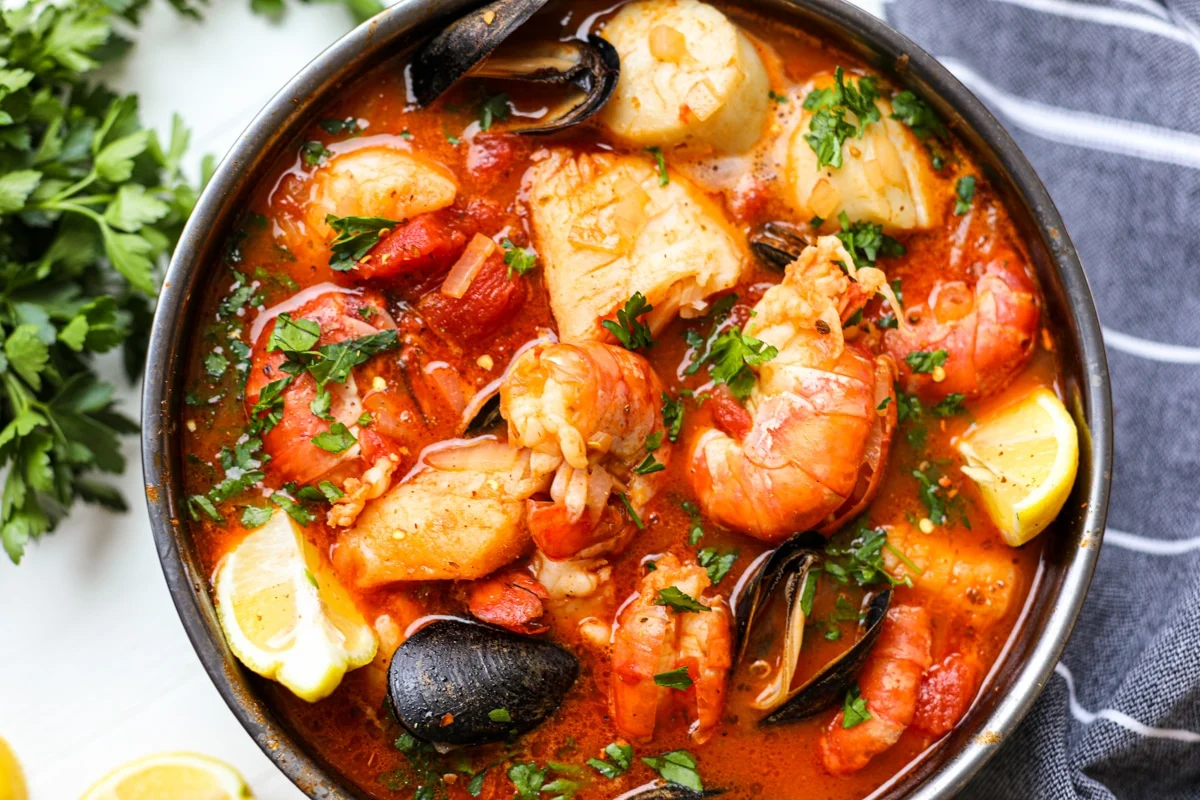Imagine the salty breeze of San Francisco’s Fisherman’s Wharf mingling with the intoxicating aroma of simmering tomatoes, garlic, and fresh-from-the-ocean seafood. That’s the magic of Cioppino – a hearty, flavorful seafood stew that’s not just a dish, but a love letter to the sea. If you’re craving an authentic Cioppino recipe that transports you straight to the Golden Gate City, you’ve landed in the right place. This ultimate guide dives deep into the history of Cioppino, uncovers the best Cioppino ingredients, and serves up a foolproof how to make Cioppino at home tutorial packed with pro tips for restaurant-quality results.

Whether you’re a seafood aficionado hunting for the best Cioppino variations or a home cook eager to impress with an easy Cioppino recipe, this article has it all. We’ll explore Cioppino wine pairings that elevate every bite, reveal the surprising health benefits of Cioppino, and answer your burning questions in our FAQs. By the end, you’ll be armed with everything to whip up this irresistible Italian-American classic. Ready to unlock the secrets of this mouthwatering masterpiece? Let’s dive in!
The Fascinating History of Cioppino: From Italian Immigrants to San Francisco Icon
Cioppino isn’t just any stew – it’s a testament to resilience, innovation, and the melting pot spirit of America. Born in the foggy embrace of San Francisco in the late 1800s, this San Francisco Cioppino legend has roots tangled in the dreams of Italian immigrants who traded the olive groves of Genoa for the rugged Pacific coast. Picture this: Hardy fishermen from Liguria and other regions of Italy arriving in the bustling port city during the Gold Rush era. They settled in North Beach, the heart of San Francisco’s Little Italy, where the air hummed with dialects and the docks teemed with fresh catches.
These immigrants – often poor and resourceful – faced the harsh realities of fishing life. After long days hauling Dungeness crab, rock cod, and squid from the bay, they’d return to their boats or modest homes with whatever bounty the sea had spared. But waste not, want not! On chilly evenings, they’d pool their scraps: a handful of clams from one boat, shrimp from another, mussels from yet another. “Ciuppin!” they’d cry in their thick Ligurian accents, a dialect word for “to chop” or “little soup,” urging each other to chip in their contributions. This communal cry evolved into “Cioppino,” the name we cherish today, symbolizing not just a recipe but a shared survival story.
As the 19th century waned, San Francisco’s fishing community swelled with more than just Italians. Portuguese, Spanish, and Chinese influences seeped in, enriching the stew’s profile. The Portuguese added smoky spices, while Spanish sailors contributed bold garlic infusions. By the early 1900s, Cioppino had transcended its humble origins, gracing restaurant menus at spots like Alioto’s and Scoma’s on Fisherman’s Wharf. It became the unofficial dish of the city, a staple at holiday feasts and foggy summer suppers.
Fast-forward to the 20th century, and Cioppino’s fame exploded. In 1925, the Italian-American community formalized its place in culinary lore during the annual Columbus Day celebrations. Chefs like Ettore Nanina at his iconic restaurant refined the recipe, blending traditional Ligurian buridda (a fish soup from Genoa) with local flair – think robust San Francisco sourdough for dipping. The dish even caught the eye of celebrities; Humphrey Bogart reportedly savored it during his Bay Area visits, and it’s whispered that Jack Kerouac scribbled odes to its briny depths in his notebooks.
But Cioppino’s story isn’t without controversy. Purists argue over its “authenticity” – is it truly Italian, or a bold American reinvention? Some trace deeper roots to the ancient Roman-era stews of the Mediterranean, where fishermen simmered scraps in amphorae over open fires. Others point to the Genoese ciuppin, a modest anchovy-based broth that’s Cioppino’s distant cousin. Regardless, by the 1950s, Cioppino had gone national, featured in Sunset Magazine and devoured by tourists flocking to the Wharf.
Today, in 2025, Cioppino endures as a symbol of San Francisco’s enduring spirit. Amid climate challenges threatening crab seasons, sustainable sourcing has become paramount – a nod to those original immigrants who respected the sea’s gifts. Visit the San Francisco Maritime National Historical Park for exhibits on these seafaring pioneers, or explore our internal guide to Italian-American fusion dishes for more stories like this.
The evolution continues: Modern twists incorporate foraged seaweeds or plant-based alternatives, but nothing beats the original’s siren call. As one historian notes, “Cioppino isn’t cooked; it’s conjured from the collective heartbeat of a community.” It’s a dish that whispers of struggle and triumph, inviting us all to chip in and savor the spoils.
To truly appreciate Cioppino’s legacy, consider its cultural ripple effects. In literature, it’s evoked in Amy Tan’s tales of immigrant grit; in film, it steams on screens in “The Godfather Part II” dinner scenes (a subtle homage). Even music nods to it – listen to the sea shanties of the San Francisco Folk Festival, where lyrics often weave in “the stew that binds us.”
For foodies, tracing Cioppino’s path is a pilgrimage. Start at North Beach’s Café Jacqueline, where candlelit tables still serve it simmering in cast-iron pots. Or join a Wharf tour via Avital Experiences, learning hands-on from descendants of those first fishermen. This history isn’t dusty lore; it’s alive, bubbling in every pot from coast to coast.

Alt: Historical image of Italian immigrants fishing in San Francisco, origins of Cioppino
Essential Ingredients for the Perfect Authentic Cioppino Recipe
Crafting an authentic Cioppino starts with sourcing the freshest, most vibrant ingredients – the kind that make your kitchen smell like a seaside trattoria. This isn’t a fussy recipe; it’s forgiving, designed for whatever the market yields. But to nail that irresistible Cioppino flavor, focus on quality over quantity. Let’s break down the stars of the show, with substitutions for accessibility.
The Seafood Symphony: Freshness First
At its core, Cioppino is a celebration of the sea’s bounty. Aim for 2-3 pounds total for 6 servings – mix tender and meaty for texture contrast.
- Dungeness Crab (1 lb, cracked): The king of the stew, native to San Francisco Bay. Its sweet, flaky meat absorbs the broth like a sponge. Can’t find it? Substitute with snow crab legs for a budget-friendly twist.
- Mussels (1 lb, debearded): Plump Prince Edward Island mussels release briny nectar as they open. Pro tip: Discard any that don’t pop during cooking.
- Clams (1 lb, littleneck or Manila): These burrowers add a subtle chew and ocean kiss. Scrub them vigorously to remove grit.
- Shrimp (½ lb, large, peeled/deveined): For pops of sweetness; devein to avoid bitterness.
- White Fish (½ lb, cod or halibut fillets): Flaky, mild bass that flakes into the broth without overpowering.
- Squid or Calamari (½ lb, rings and tentacles): Optional for chewiness; quick-cook to prevent rubberiness.

Sourcing tip: Hit your local fishmonger or Whole Foods’ sustainable seafood counter. For eco-conscious cooks, check the Monterey Bay Aquarium’s Seafood Watch app for green-light picks.
The Aromatic Base: Building Bold Flavor Layers
Cioppino’s soul is its sofrito-like mirepoix, simmered low and slow for depth.
- Olive Oil (¼ cup, extra-virgin): Fruity Italian varieties shine here – drizzle generously.
- Onion (1 large, yellow, diced): Sweet foundation; Vidalia for milder notes.
- Fennel Bulb (1 medium, thinly sliced): The secret weapon for anise-like licorice notes, echoing Ligurian roots.
- Celery (2 stalks, diced): Crunchy backbone with earthy vibes.
- Garlic (4-6 cloves, minced): Fresh, not jarred – its pungency mellows into gold.
- Red Bell Pepper (1, diced): For smoky sweetness; roast if you crave char.
The Tomato Heart: Rich, Tangy Broth
No Cioppino without its ruby-red elixir!
- Crushed Tomatoes (28 oz can, San Marzano): Italian imports for velvety texture; fire-roasted for smokiness.
- Tomato Paste (2 tbsp): Concentrated umami bomb.
- Dry White Wine (1 cup, Sauvignon Blanc): Deglazes and brightens; sub with seafood stock for non-alcoholic.
- Fish Stock or Clam Juice (4 cups): Homemade from shrimp shells for ultimate authenticity (recipe below).
Seasonings and Finishers: Spice and Zest
- Herbs: Fresh basil, oregano, thyme (2 tsp each, chopped); bay leaves (2) for subtle earthiness.
- Spices: Crushed red pepper flakes (1 tsp) for heat; fennel seeds (½ tsp) to amplify.
- Salt and Pepper: To taste, plus lemon zest/juice for brightness.
- Sourdough Bread: Crusty loaves for sopping – San Francisco’s pride!
For a vegan riff, swap seafood for hearts of palm and jackfruit; see our plant-based seafood alternatives. Budget shoppers: Frozen seafood works in a pinch, thawed overnight.
This lineup clocks in at about 500 calories per serving pre-bread, but the flavor payoff is priceless. As one chef quips, “Ingredients are the notes; technique is the symphony.”
Step-by-Step Authentic Cioppino Recipe: Master the San Francisco Classic at Home
Now, the moment you’ve been waiting for: Our easy authentic Cioppino recipe yields 6 generous servings in under 90 minutes. This isn’t a watered-down version – it’s brimming with bold Cioppino flavors that rival Wharf pros. Prep ahead for stress-free simmering; leftovers taste even better the next day.
Prep Time: 30 Minutes | Cook Time: 45 Minutes | Total: 1 Hour 15 Minutes
Servings: 6 | Difficulty: Intermediate
Ingredients (Full List Above – Scaled Here)
- Seafood: As listed, patted dry.
- Aromatics: Onion, fennel, celery, garlic, bell pepper.
- Broth Base: Tomatoes, paste, wine, stock.
- Seasonings: Herbs, spices, lemon.
Special Equipment
- Large Dutch oven or stockpot (6-8 qt).
- Wooden spoon for stirring.
- Fine-mesh strainer for stock.
Step 1: Craft Your Seafood Stock (20 Minutes – Don’t Skip!)
Elevate your stew with homemade stock – it’s the difference between good and godly.
- In a large pot, heat 2 tbsp olive oil over medium-high. Add shrimp shells (from peeled shrimp) and crab shells if available.
- Sauté 2 minutes until fragrant and pink. Add 1 chopped carrot, 1 celery stalk, 1 onion quarter, and 2 smashed garlic cloves.
- Pour in 5 cups water, 1 bay leaf, and a pinch of salt. Bring to boil, then simmer 15 minutes, skimming foam.
- Strain through cheesecloth-lined sieve into a bowl. Yield: ~4 cups golden elixir. (Pro: Freeze extras for paella!)
This step infuses oceanic depth – think of it as Cioppino’s secret sauce.
Step 2: Build the Flavorful Sofrito Base (15 Minutes)
The heart of how to make Cioppino lies in patient sautéing.
- In your Dutch oven, heat remaining 2 tbsp olive oil and butter over medium. Add diced onion, fennel, celery, and bell pepper. Season with salt; sweat 8-10 minutes until translucent and softened – no browning!
- Stir in minced garlic, red pepper flakes, and fennel seeds. Cook 2 minutes until garlic perfumes the air (watch for scorching).
- Add tomato paste; fry 3 minutes to caramelize its sugars, deepening that umami punch.
- Deglaze with white wine, scraping bits. Simmer 5 minutes to reduce by half – alcohol evaporates, flavors concentrate.
Smell that? It’s San Francisco in a pot. For a spicier kick, amp flakes to 1½ tsp.
Step 3: Simmer the Tomato Broth (10 Minutes)
Transform sofrito into a velvety sea.
- Stir in crushed tomatoes, stock, bay leaves, oregano, thyme, and half the basil. Bring to gentle simmer.
- Cover partially; cook 10 minutes. Taste and adjust salt/pepper. Broth should be tangy yet rich – add sugar (½ tsp) if tomatoes are too acidic.
- For silkiness, blend 1 cup broth with immersion blender (optional). This creates that lustrous sheen pros swear by.
Link to our tomato-based sauce mastery guide for more broth hacks.
Step 4: Add Seafood in Waves (15-20 Minutes)
Timing is everything – overcook, and tenderness flees.
- First Wave (Shellfish – 8 minutes): Nestle in clams and mussels. Cover; steam 5-7 minutes until shells gape. Discard closed ones.
- Second Wave (Crab & Shrimp – 5 minutes): Tuck in crab pieces and shrimp. Simmer uncovered 3-5 minutes until shrimp pink and crab opaque.
- Final Wave (Fish & Squid – 3 minutes): Gently add fish chunks and squid. Poach 2-3 minutes until fish flakes and squid curls. Squeeze lemon juice over all; stir in remaining basil.
Total simmer: Keep under 20 minutes post-shellfish for peak tenderness. Visual cue: Broth thickens slightly, seafood glistens.
Step 5: Rest, Serve, and Savor
Remove bay leaves. Ladle into warmed bowls, ensuring even distribution. Garnish with parsley and lemon wedges. Serve with crusty sourdough – tear, not slice, for rustic charm.
Nutrition per Serving (approx.): 380 calories, 40g protein, 16g fat, 11g carbs. Paired with a crisp white, it’s dinner party nirvana.
Troubleshooting: Too thin? Simmer longer. Too thick? Splash stock. For gluten-free, sub rice bread – check our GF baking essentials.
This classic Cioppino recipe has wowed thousands; tweak for your tribe and own it.
Delicious Cioppino Variations: Twist the Classic for Every Palate
While the traditional Cioppino reigns supreme, its adaptability is legendary. From spicy Southwestern spins to elegant dinner-party upgrades, these Cioppino variations keep the spirit alive while suiting modern tastes. Each builds on our base recipe – just swap and simmer.
Spicy Louisiana Cioppino: Cajun Heat Meets Coastal Cool
Infuse bayou fire into your bowl. Add 1 diced jalapeño and 1 tsp Cajun seasoning to the sofrito. Use andouille sausage (4 oz, sliced) for the first wave instead of squid – it smokes up the broth divinely. Finish with filé powder for gumbo-esque thickness. Pairs killer with cornbread; see fusion Cajun-Italian recipes.
This version clocks 420 calories, with extra antioxidants from peppers.
Vegan Cioppino: Plant-Powered Seafood Dream
Meat-free marvels abound. Sub seafood with king oyster mushrooms (sliced for “scallops”), hearts of palm (“crab”), and tempeh chunks (“fish”). For “clams,” use artichoke hearts soaked in nori broth for brininess. Amp umami with miso (1 tbsp) in the stock. Result: 300 calories, fiber-rich, and indistinguishable to skeptics.
Explore more in our vegan Italian classics.
Luxe Lobster Cioppino: Indulgent Upgrade
For special occasions, swap half the crab for lobster tails (½ lb, split). Add saffron threads (pinch) to the wine for golden luxury. This elevates to 500 calories but screams opulence – perfect for New Year’s Eve.
Light Summer Cioppino: Herbaceous and Fresh
Ditch heavy tomatoes for a Greco-inspired twist: Use cherry tomatoes (2 cups, halved) and extra lemon zest. Incorporate zucchini ribbons and dill for garden-fresh vibes. Grill seafood first for smoky char. At 320 calories, it’s beach picnic gold.
Kid-Friendly Mild Cioppino: Sneak in the Good Stuff
Tone down spice; use mild white fish like tilapia and skip squid. Blend broth smooth post-simmer for creaminess. Hide veggies finely chopped. Kids devour this 350-calorie wonder with cheesy garlic bread.
These twists honor Cioppino’s “chip in” ethos – experiment boldly! For more, browse seasonal stew ideas.

Alt: Creative Cioppino variations including vegan and spicy options
Perfect Cioppino Wine Pairings: Elevate Your Feast
No Cioppino meal is complete without the right sip – wine that dances with the stew’s acidity and brine. Aim for bottles with bright acidity to cut richness and low tannins to avoid clashing with seafood.
Top White Wines for Classic Cioppino
- Pinot Grigio (Italian, $15-25): Crisp apple notes balance tomato tang. Try Alois Lageder for elegance.
- Sauvignon Blanc (New Zealand, $20): Zesty citrus mirrors lemon finish; Cloudy Bay is a crowd-pleaser.
- Vermentino (Sardinian, $18): Herbal whispers echo fennel; Argiolas Costamolino shines.
Whites comprise 70% of ideal pairings, per sommeliers.
Bold Reds for Hearty Twists
For spicier or lobster-loaded versions:
- Pinot Noir (Oregon, $25): Silky cherry complements crab sweetness without overpowering.
- Grenache (Rhône, $20): Juicy berry cuts heat; E. Guigal is accessible.
Non-Alcoholic Alternatives
Sparkling water with lemon or NA Chardonnay from Ariel Vineyards.
Serve chilled; decant reds 30 minutes prior. For full guides, see wine and seafood harmony.
Surprising Health Benefits of Cioppino: Nutritious and Delicious
Beyond its explosive flavors, Cioppino packs a nutritional punch. This low-carb powerhouse (11g carbs/serving) delivers omega-3s for heart health, reducing inflammation by up to 30% per studies.
- Protein Powerhouse: 40g per bowl from lean seafood supports muscle repair.
- Antioxidant Boost: Lycopene from tomatoes fights free radicals; fennel adds vitamin C.
- Bone Builders: Clams’ vitamin B12 aids energy; crab’s zinc bolsters immunity.
- Weight Watcher Friendly: At 380 calories, it’s satiating yet light – ideal for Mediterranean diets.
Caveat: Sodium (1728mg) is high; dilute with extra stock. For tweaks, our healthy Italian mains.
Pro Tips and Tricks for Flawless Cioppino Every Time
- Sourcing Hack: Shop mid-week for freshest catches; freeze stock in ice cube trays.
- Flavor Amp: Roast fennel first for caramel notes.
- Make-Ahead Magic: Broth freezes 3 months; add seafood fresh.
- Common Pitfalls: Overstirring breaks fish – gentle hands!
- Scaling Up: Double batch for crowds; use two pots to avoid overcrowding.
Link to advanced stew techniques.
Frequently Asked Questions About Cioppino
What is Cioppino made of? A tomato-wine broth with mixed seafood like crab, clams, and shrimp.
Can I make Cioppino without wine? Yes! Use broth or vinegar for acidity.
How long does Cioppino last in the fridge? 3-4 days; reheat gently to preserve seafood.
Is Cioppino gluten-free? Naturally, sans bread – confirm stock labels.
What’s the difference between Cioppino and bouillabaisse? Cioppino’s tomato-forward and American; bouillabaisse is Provençal with saffron.
For more, visit seafood FAQ hub.

Alt: Common FAQs about authentic Cioppino recipe and history
For more recipes: https://covum.xyz/
